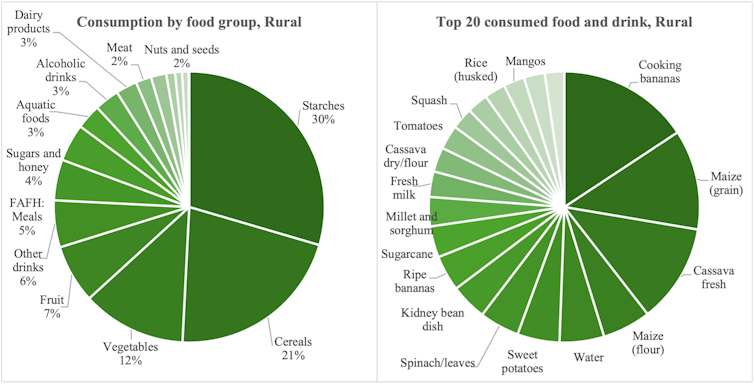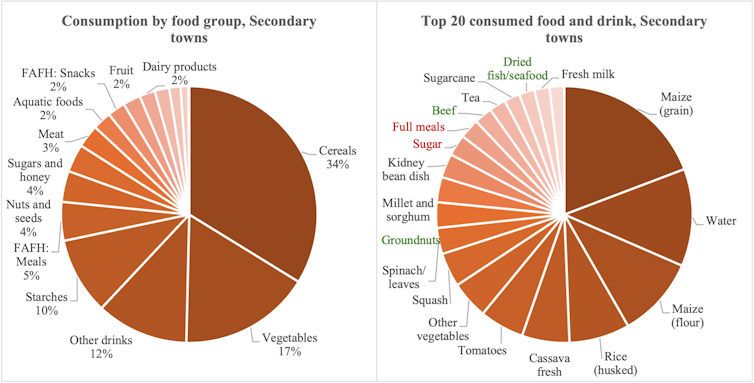Cities are growing faster in sub-Saharan Africa than elsewhere, with an annual urban population growth rate of around 4% compared to the world average of 1.5%.
Across the continent the urban share of the total population is projected to increase to 50% by 2030 and 60% by 2050.
Urbanisation is associated with lifestyle changes such as less physical activity and less labour-intensive work. This is often accompanied by an increased intake of high-calorie fast foods, snacks, and sugar-sweetened beverages.
This combination has contributed to rising obesity in cities in low- and middle-income countries. At the same time, undernourishment and micronutrient deficiencies remain a problem.
In Tanzania, about 37% of the population lives in urban areas. About 5.3 million people live in Dar es Salaam, 28% of the urban population.
As an agricultural economist focusing on nutrition, my latest research looks into the difference in dietary quality between rural areas, secondary towns and the commercial capital Dar es Salaam.
What people eat differs considerably depending on where they live. Any public health campaign to improve nutrition needs to target these areas differently.
Food diaries
Using data from food diaries recorded by 1,506 households over a two-week period, I calculated how many calories, macronutrients and micronutrients were consumed and compared them to the recommended requirements for a healthy life.
The data was collected in five regions of Tanzania, each representing a different ecological and economic zone. In our sample, 988 households lived in rural areas, 304 in towns and 214 in Dar es Salaam.
Besides food diaries, our data also included information on household characteristics and their socioeconomic status. This included details on educational level, assets and food production.
Homegrown or highly processed?
We found that people living in rural areas suffered from the highest deficiencies.
This was because they were not eating sufficient quantities of food.
Most food was home-grown, which provided beneficial nutrients, but diets were not diverse enough to provide all the nutrients needed for healthy living.
At the opposite end of the scale, residents of Dar es Salaam also ate unhealthy diets, but for very different reasons.
They relied heavily on processed cereal products and ready-made meals. This meant that they weren’t getting enough fibre and micronutrients and also ate too many saturated fats and sugar.
Comparatively the diets of households in secondary towns, those with a population of 500,000 or fewer, were the healthiest of the three.
Residents still produced some of their own food, and at the same time had more access to markets, more food choices to diversify their diets, and higher incomes to afford this diversity.
Calories, nutrients or a lack thereof
1.) Rural households primarily consumed starches, cereals, vegetables and fruit, making up 29%, 21%, 12% and 7% of their diet respectively.
Plantains, maize, cassava, sweet potatoes and spinach were the most consumed food items in rural areas.

These diets are considered healthy, but many still faced severe deficiencies. About 48% of households were not reaching the daily recommended calorie intake. Between 40% and 80% of households in these areas didn’t consume enough of the vitamins and minerals that are important for physical and mental development, such as folate, vitamin B12, calcium, iron and zinc.
Many of these nutrients are found in animal foods, which made up a small share of rural diets.
2.) In secondary towns, maize, rice, cassava, tomatoes and squash were eaten most frequently. In terms of quantity, these households tended to consume more, leading to lower levels of nutritional deficiencies than in rural areas.
About 26% of households did not meet the recommended calorie intake, but this was significantly better than in rural areas.

The additional consumption of foods such as groundnuts, beef and dried aquatic foods further improved the nutritional adequacy of their diets.
Read more: The missing piece in fighting Africa's malnutrition problems
These households consumed about 20% more calories, fats and proteins, all necessary for a healthy diet. The consumption of thiamine, niacin, vitamin B12, magnesium, iron and zinc also increased by between 15% and 45% compared to rural diets.
3.) Dietary patterns changed a lot when we compared rural areas and towns to a megacity like Dar es Salaam. Cereals, including highly processed cereal products like bread and pasta, made up 25% of the bulk of the city diet.
Full meals bought outside the home were the next largest category. Vegetables made up only about 8.5% of their diet. The consumption of snack foods such as chapatis and doughnuts was also high.

These households were overconsuming fats, saturated fats and sugar. They were underconsuming fibre, key vitamins such as thiamine, folate, vitamin C and E and minerals such as calcium and potassium, exposing them to the risks of obesity and micronutrient deficiencies.
Next steps
A lack of essential nutrients has a host of knock-on health effects, such as decreased cognitive function, fatigue, intensified illness and infections.
At the same time, overconsumption of potentially harmful food substances such as fats and sugars can lead to health risks such as obesity, diabetes and cardiovascular disease.
The findings highlight the need for a varied approach to dealing with nutrient intake and tackling problems such as rising obesity rates. One size won’t fit all.
Read more: African countries must embrace the concept of good food as good medicine

